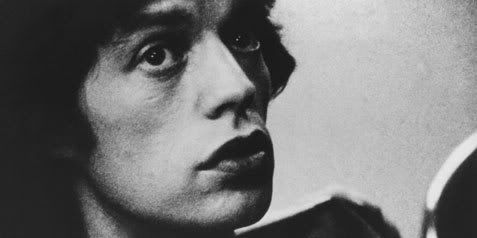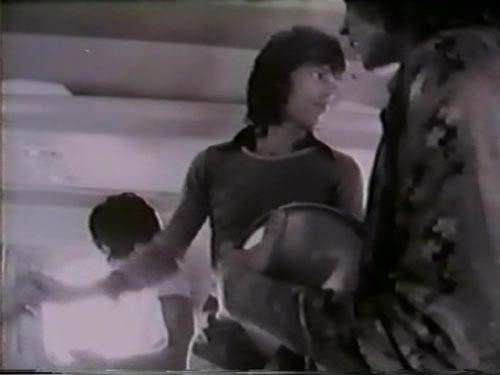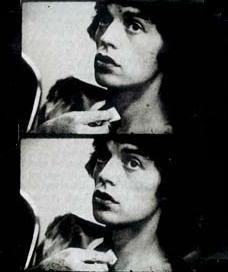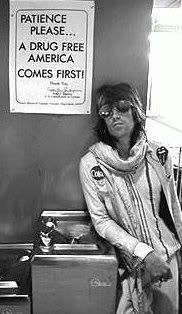or The Rolling Stones' Cocksucker Blues
"Except for the musical numbers
the events depicted in this film
are fictitious. No representation
of actual persons and events
is intended."
the events depicted in this film
are fictitious. No representation
of actual persons and events
is intended."
You know you're headed into murky water when a documentary (if something this honest and improvised can be called such) starts with a message like that.
(This one will be a challenge to find if you want to see it, because it was made in 1972 and never released. You can only attain it through the purchase of a bootleg copy or through certain methods online. The Rolling Stones, though they reportedly liked the film, saw that releasing it would hurt their reputation, would only add to the weight against them after the debacle at Altamont (documented in Gimme Shelter, which I intend to see soon). The court ruled that the director be present at all future screenings, which rather limits the distribution rights.)
I recommend watching the film before reading any further.

Jim Jarmusch's line about this film is well-known, and for good reason. According to Jarmusch: "definitely one of the best movies about rock and roll I’ve ever seen. . . . it makes you think being a rock and roll star is one of the last things you’d ever want to do."
And that sums the film up nicely, in a lot of ways, but it only captures the primary, over-arching theme of the film: the ennui of that lifestyle, travelling between shows, and the attempt to dispell it using drugs, sex, games, anything; the too seldom relief of performance; the utter lack of glamour in the rock lifestyle, the fact of the humanity behind the myth on-stage; the moments between that everyone forgets, and how long they can be.
Most people writing about this film write about that (the links below are fine examples). I could too, because it's a strong idea and it's documented brilliantly (poetic vérité, as someone said), it has plenty to offer; but I won't. Instead, because that's already been done and because I have many other things to say, I'll take a more specific approach, dwelling on particular scenes or moments that either embody or transcend that theme. Moments that capture something beyond mere backstage action.
If any moment epitomizes this pervading sense of ennui, it's the scene in the locker room. It's stripped of all the illusions: no drugs, no distractions, no music, no jokes, not even conversation. Just two people so miserably inactive that they've sought the only remaining refuge: sleep.
Other scenes deal with this mid-tour boredom, but the ones that interest me most are those farthest from the rock lifestyle. For instance, when a small group consisting of Jagger and some others pile into a car in an attempt to escape the restraints of tour life. They're still distinctly confined by the limits of the car, but they get moments outside: stretching their legs, listening to an old man play guitar. This trip, something so simple as a car ride, becomes a tremendous relief to them, a rare and cherished freedom. I don't mean to exaggerate its importance, but it's the only time in the whole film where we see them totally outside of the dreaded tour cycle. They can behave normally, have some normal conversation. Jagger talks about how hungry he is, and how food in the South, even in coffee shops, is the best in America (a truer statement I've ne'er heard). They talk about seeing green things. It's an escape, and for a while they seem human, just human.
In a scene just afterward, perhaps the same trip, they're hanging out with some folks (a few old black guys they probably met by chance) in a small pool room. Some are playing pool, a few are drinking, they're talking and joking around with one another. These are rare moments, compared to the rest of the film, but they let you breath easy and you see that they had good moments, and that these good moments were often the simple ones.

Robert Frank, in preparing the documentary, had the brilliant idea of bringing a camera for everyone and plenty of film; this meant that anyone could pick up a camera any time and film whatever they wanted to, and that's just what they did. The sound they captured is limited, which explains the frequent use of non-diegetic sound and music, but we get plenty of spontaneous events from a series of perspectives. We see people reacting to the camera: a girl waving in front of it goofily, people smiling at it like the girl in the mirror, performing for it because they're aware of its presence. It's thanks to this that the footage is as diverse and compelling as it is. This is how we see Keith Richards and the saxophonist throwing the tv off the balcony, just to film it busting on camera. Again, like normal guys, practically small town kids who are so bored that breaking things is the best entertainment. They laugh about it like a teenage boy would laugh. One of the film's most admirable traits is the disspelling of the illusion. Of the Rolling Stones myth.
It's impossible to ignore the music, though. You would be foolish to try. Now we see plenty of performance footage, sure, but music has another place in the lives of these wanderers: again, between shows. The presence of music throughout their lives is obvious in the film, and while it's far from a point of focus, it's definitely present. On the airplane, during the bizarre, half-forced orgeistic party (apparently started when Robert Frank said that nothing ever happened). We see Richards and Jagger beating to percussion as they watch the girls being stripped, making the occasion some tribal frenzy. They're just having fun, but we must note their inclination to pick up instuments and enhance the performance through their semi-rhythmic clatterings. That's probably the most outstanding example, but we see it occur in other circumstances: during their frequent and impromptu rehearsals, during unexpected moments where suddenly Richards is playing piano with some black guys or a group has gathered 'round to improvise a song. And in contrast to everything else, we have the stage performances and we see then the band's irresistible energy, the myth coming to life, as if they must hibernate during the day and only truly wake for their fans.
Whenever I think of the music and its presence in the film, I think of the scene with the music box. Everyone going about their business, looking at costumes or talking about this and that. And behind it all, we hear the delicate tremblings of a music box playing its beautiful and simple song (taken from something classical, although I can't recall the title of the piece). The cameraman asks if Bianca Jagger will wind the box once more, and the music persists, rising and dying out before being wound up to rise again.
The other scene I think of in regards to music is the awesome Stevie Wonder performance, where both Stevie Wonder and Mick Jagger are stumbling epilleptically across the stage together. The performance is actually pretty remarkable, in spite of the poor video quality (for the most part, the mid-level film quality and bootleg decomposition makes the experience feel more underground and intimate, but the performance action is often muddled). This was supposedly one of the Stones' best tours and footage like this supports a claim like that, whatever may have happened off-stage.

So far we have the Rolling Stones as: the greatest rock band ever, the listless wanderers who can never leave their caravan, simple men separated from the myths that tower over them. But have we seen them as the masturbating, narcissistic self-voyeurist?
Robert Frank brought a lot of camera, and boredom abounded, so we shouldn't be surprised that it happened. But it's still beautiful to see Jagger jerkin' it, filming himself in what seems to be a mirror in the ceiling. Present here is one of the great uses of non-diegetic sound throughout the film; it's utilized plentifully because, as I said before, they had more footage than sound. But it merely serves to highlight the beginning of a string of bizarre and perverse circumstances sewn through the film. The film always manages to be interesting, mystifying, or revealing in some way, and it often manages instances of circumstantial beauty and poetry. But none are more bewildering and fascinating than the following:
We see a girl doing cocaine. She's not a young girl, but it soon becomes apparent that it's her first time doing cocaine. After the effects have caught hold of her and she's had a little while to experience it, she says "I didn't know what it'd be like, but, I thought it would be real good cuz they're so good, I knew it would be real good. But I didn't know it would be this good." We have the Stones as Lucifer, corrupting the innocent (Mick Jagger has been called "the Lucifer of rock").
We see the girl who has nothing to live for but the Stones, who's very open about her misery and problems (lost her child because she did acid and so what, the kid was born on acid it can be raised on it too), who'd just as soon kill herself if she doesn't get into the show cuz she doesn't care about anything else now. We have the Stones as Savior, giving purpose to the desperate.
And there are other moments. Darker and stranger moments.

Recall the segment where a group has split from the regular route to ride around in a car. After Jagger listens to the old man play guitar, just as the old man closes his car door, a cock crows. We are shown one of those homemade signs you sometime see in the Bible belt, a simple white cross declaring "Repent now" as the cock crows. Frank shows us this sign several times in this sequence. We see a hand reaching from between the bars in the prison (seems like Jagger got that footage), almost as if they're reaching for the Stones. Repent now.
And the part of the film that branded itself like hot iron onto my memory. We are in a small hotel room. The footage is almost colorless, just grey with a hint of what might be green. A naked girl laying on her back, alone on one of the beds. She uses her arm on a pillow as a pillow. She grazes her fingernails idly along her body: at first around her left nipple (her breasts flat against her chest), then moving downward across her stomach, saying "I saw fireflies last night." Night is punctuated by the arrival of her hand at her vagina (unshaven; this is 1972), where she lingers just an instant before roving on.
Why it stays with me, I can't say. Rest assured, it has nothing to do with the clear shot of her bush. But those words, at that moment. Surely there's a context or a reason someplace, but we are not provided that luxury. We have only that event, existing independently of its natural surroundings. Perhaps it reminds me of a time, a few summers ago (2005), after rehearsing The Tempest (I was Caliban) one night we stepped outside and a girl, a friend from New Orleans, was startled by the presence of these random glows, flickers of light throughout the air. She'd never seen fireflies before, she thought they were make-believe, something like fairies. And I remember her awe. And maybe I associate that with this filmed memory, its distorted and unusual companion moment in time. That might be why it stays with me, but I doubt that it's only that.
That's all I'm going to say about the film, lest this run to unbearable lengths, but just one more tidbit in relation to this blog:
In the last quarter of the film, some heroin dealer is talking about this society of heroin users and their legacy. It's an interesting monologue, and it almost sounds scripted, but something stood out when he talked about legacy. He mentioned Samuel Taylor Coleridge (who I haven't mentioned here, but have been studying) and Jean Cocteau (who I've written about twice and will write about twice more). So I thought that was a weird coincidence.
Some of the links tend to repeat a few things about the history of the film, but they all have their own worthwhile take on it and each offers a different variety of detail and background info.
Links:
Rolling Stone article
Thorough, lots of background
Write-up with ample detail
Guardian article

No comments:
Post a Comment